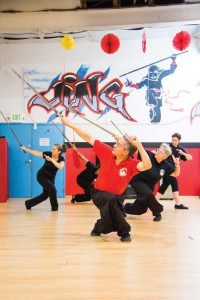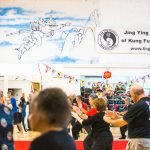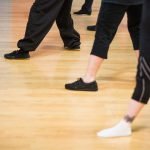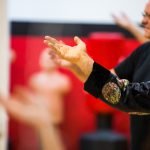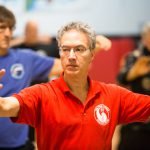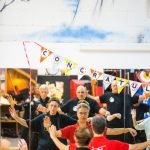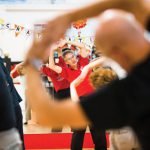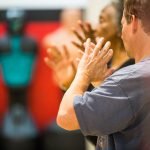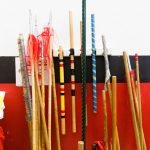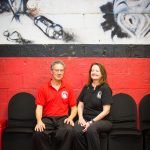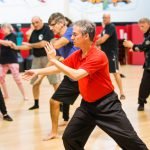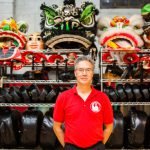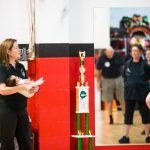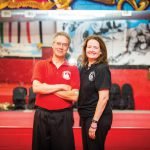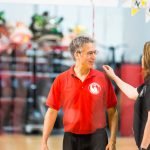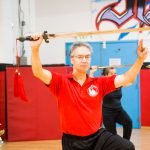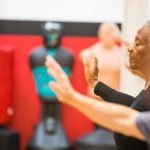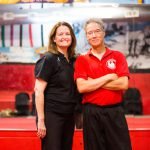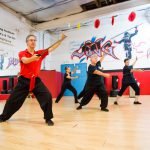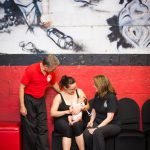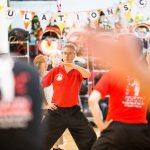+ By Leigh Glenn + Photography By Mary Ella Jourdak
You might have seen Billy Greer and his students—children, parents, and elders—demonstrating the Chinese martial art of Taiji (tai chi) at the William Paca House or Maryland Hall for the Creative Arts. If you watched them long enough, you might have felt tension easing out of your body, for even watching Taiji has that effect. But what you won’t have seen is the years-long exploration of movement, the constant “preparation posture” that is Greer’s life.
Gongfu (kung fu), literally hard work and time, characterize Greer, age 59, who has moved steadily to where he is today, heading up Jing Ying Institute in Severna Park, where he teaches Gongfu and Taiji and enjoys hosting Chinese martial arts teachers. It’s also where he and his wife, Nancy, spearhead outreach for a variety of community-based fundraisers that have yielded more than $60,000 for local and global needs since the 2005 Asian tsunami.
A “Navy brat” from Trinidad, Greer was small for his age, had poor sight, a speech impediment, and was nonathletic. He related better to books than people until a junior-high wrestling class, during which he was matched against students his size, his vision wasn’t a disadvantage, and he focused on strategy. He embraced the sport and wrestled for Bayside High School in Virginia Beach. Hard work and time led him to join the gymnastics and cross-country teams to enhance strength and flexibility and improve endurance. By senior year, he captained all three teams. He continued running and wrestling while in college at Hampden-Sidney, Hampden Sydney, Virginia, where he majored in biology and pre-med and earned various sports awards.
In the 1970s, Bruce Lee and the Kung Fu TV series popularized martial arts. But despite reading about martial arts, watching martial arts films, and constantly talking about martial arts, Greer didn’t take the plunge then—Nancy did. In college, she gave him a set of nunchucks, a traditional Okinawan martial arts weapon, and he taught himself how to use them. They married in 1982, and five years later, she gave him a one-month trial membership to a karate school in Glen Burnie. Not quite what he wanted, it spurred him to examine other schools. At the next school, they studied Tian Shan Pai Gongfu with Tayari Casel. Casel, an African American Gongfu practitioner, had studied with Dennis Brown, the most senior disciple of the man who brought Tian Shan Pai Gongfu to the United States, Grandmaster Willy Lin.
Greer did what he always does when he’s serious about something: he got a book—in this case, an out-of-print book that he photocopied—and began studying. The book’s author, Grandmaster Lin, had studied Tian Shan Pai Gongfu with the Chinese teacher who brought it to Taiwan. According to the book, Lin had his own school in DC’s Chinatown. But the book was out of date. Greer checked and found Lin no longer taught, dashing hopes of studying with him.
In 2001, the Greers began studying at Jing Ying in Severna Park, run by instructor Mary Martin. It sprang from East West Martial Arts, an Annapolis school that had closed. Its 6,000 square feet and high ceilings were ideal for traditional Chinese martial arts. After three years, says Greer, Martin asked if the Greers had ever thought of running a school. By August 2004, she told them if she couldn’t find a buyer, she would have to close the next month.
“Nancy and I had our previous Gongfu school close on us, and we didn’t want to go through that again,” Greer says. “Plus, our kids had gotten really involved at the school, and it had become a big part of their lives.”
Without financial data or the vacationing landlord to confirm the lease, the Greers followed their hearts and took over the school. But like any infant, the school needed
full-time parents. Greer, whose work had shifted from running a lab to IT and who had kept a consulting business for lab-related work, quit both. Despite the income hit, Nancy eventually moved to the school full-time, too.
In 2005, Greer finally met the two men who influenced him the most and began training directly with them—Grandmaster Lin and Grandmaster Chen ZhengLei, a descendant of Chen WangTing, who lived from 1580 to 1660, and reportedly combined his previous training with theories from early Qigong to create Taiji. Because Taiji was banned during the Cultural Revolution, Chen ZhengLei trained in a cemetery to avoid detection. “The flat area of dead grass from his training soon spawned stories of ghosts and evil spirits that helped ensure no one was likely to venture out and discover him training at night,” Greer says.
Greer went through traditional BaiShi ceremonies with Lin and Chen, which means he is a formal disciple of both—a third-generation inheritor of Tian Shan Pai Gongfu and a twelfth-generation inheritor of Chen Taiji. For 2018, Greer is organizing a trip to Taiwan for Lin, who turns 80, and to Chen Village in Henan Province, China for Chen, who turns 70. Both, says Greer, move like men half their age.
“I don’t know how I got so lucky as to be accepted as a disciple of two people who epitomize the ideal of the ‘scholar warrior,’” he says.
During Taiji warm-up stretches, Greer often sways or bounces gently to engage his whole body. Focusing on breathing and slowness creates relaxation and enhances the ability to learn movements correctly and efficiently. It also helps develop a hyperawareness that integrates mind and body, especially as students build up “listening energy,” says Greer, which is paying attention to all the senses.
Full classes—whether at 7 a.m. or 8 p.m.—highlight students’ interest in motion and well-being as well as Greer’s enthusiasm. He tells stories or imparts information from studies of Taiji’s benefits. “When I am passionate about something, I love to share it with others,” he says. “There is nothing I enjoy more than figuring out how to explain something to someone so the switch turns on and they get it.” █
- Participants in a Tai Chi class.
- Participants in a Tai Chi class, Billy Greer leads.
- Participants in a Tai Chi class.
- Participants in a Tai Chi class.
- Billy Greer.
- Billy Greer leads Tai Chi class.
- Billy Greer leads a Tai Chi class.
- Billy Greer leads a warm up during a Tai Chi class.
- A “future Kung Fu and Tai Chi master” – Payton is the newest addition to the Greer family.
- Nancy Greer makes announcements after class about Halloween parties and fundraising, while holding her grandson, Payton.
- Participants in a Tai Chi class.
- Blunted weapons.
- Billy + Nancy Greer.
- Three generations of Greers.
- Billy Greer leads a warm up during a Tai Chi class.
- Billy Greer.
- Billy Greer, standing in front of traditional Chinese Lion costumes.
- Nancy Greer makes announcements after class about Halloween parties and fundraising, while holding her grandson, Payton.
- Billy Greer.
- Billy + Nancy Greer.
- Billy Greer laughs with wife Nancy after class.
- Photography by Mary Ella Jourdak – see more at www.maryellajourdak.com
- Participants in a Tai Chi class.
- Billy + Nancy Greer.
- Participants in a Tai Chi class utilizing movements with weapons, Billy Greer leads.
- Three generations of Greers.
- Billy + Nancy Greer.
- Participants in a Tai Chi class utilizing movements with weapons, Billy Greer leads.
- Traditionally made Chinese lion costumes.
- Three generations of Greers.
- Billy Greer leads a Tai Chi class.


